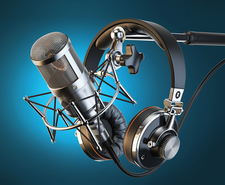Mastering and mixing with Ardour
Sound Explorer

Once you get your podcast operation up and running, you might decide you want a real mixer and some higher-end software. We'll introduce you to Ardour and get you started with some basic audio hardware.
Podcasting often occupies a space on the low end of the audio recording spectrum. All you really need is a computer, suitable software, and a microphone. Some users, however, might wish to avoid this most basic scenario. You might ask, "If I'm going to all the trouble to set up a studio for podcasting, what else can I do with it?" Or you might want your studio to grow into something more sophisticated. Perhaps you are a musician yourself? Or you wish to host live music – or other performance alternatives that require mixing and multiple mics.
In these scenarios, you could easily outgrow the simple mic+Audacity configuration. If you're looking for something more, try Ardour.
Ardour [1] is still considered the reference application as a free tool for recording and mixing on Linux. A variety of alternatives also exist – for instance, Muse is a good option if you are composing music with MIDI, and Qtractor offers some innovative features for working loops and samples – but when it comes to mixing and mastering, Ardour is unsurpassed.
[...]
Buy this article as PDF
(incl. VAT)
Buy Linux Magazine
Subscribe to our Linux Newsletters
Find Linux and Open Source Jobs
Subscribe to our ADMIN Newsletters
Support Our Work
Linux Magazine content is made possible with support from readers like you. Please consider contributing when you’ve found an article to be beneficial.

News
-
Akamai Will Host kernel.org
The organization dedicated to cloud-based solutions has agreed to host kernel.org to deliver long-term stability for the development team.
-
Linux Kernel 6.14 Released
The latest Linux kernel has arrived with extra Rust support and more.
-
EndeavorOS Mercury Neo Available
A new release from the EndeavorOS team ships with Plasma 6.3 and other goodies.
-
Fedora 42 Beta Has Arrived
The Fedora Project has announced the availability of the first beta release for version 42 of the open-source distribution.
-
Dash to Panel Maintainer Quits
Charles Gagnon has stepped away as maintainer of the popular Dash to Panel Gnome extension.
-
CIQ Releases Security-Hardened Version of Rocky Linux
If you're looking for an enterprise-grade Linux distribution that is hardened for business use, there's a new version of Rocky Linux that's sure to make you and your company happy.
-
Gnome’s Dash to Panel Extension Gets a Massive Update
If you're a fan of the Gnome Dash to Panel extension, you'll be thrilled to hear that a new version has been released with a dock mode.
-
Blender App Makes it to the Big Screen
The animated film "Flow" won the Oscar for Best Animated Feature at the 97th Academy Awards held on March 2, 2025 and Blender was a part of it.
-
Linux Mint Retools the Cinnamon App Launcher
The developers of Linux Mint are working on an improved Cinnamon App Launcher with a better, more accessible UI.
-
New Linux Tool for Security Issues
Seal Security is launching a new solution to automate fixing Linux vulnerabilities.

